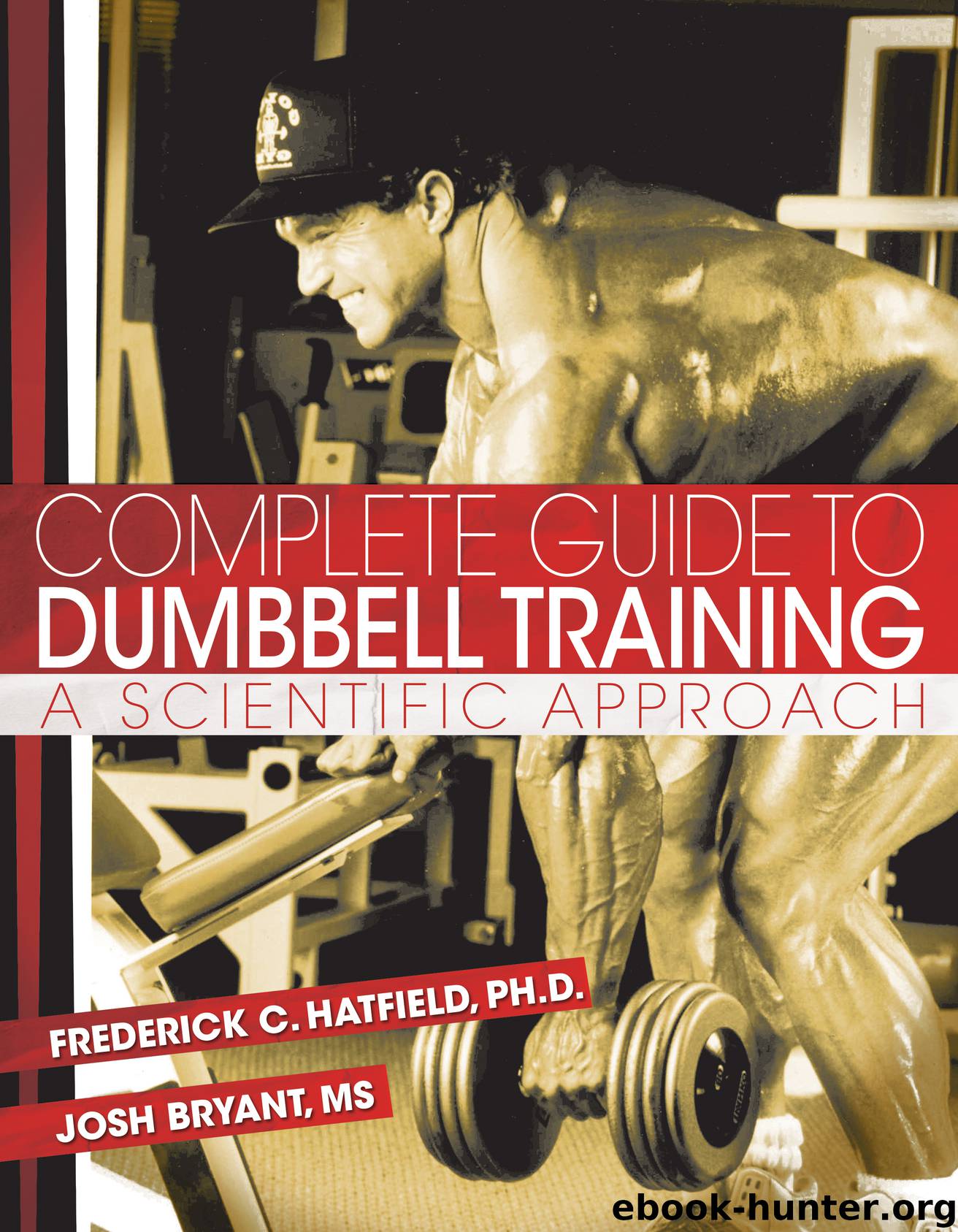Complete Guide to Dumbbell Training by Fred C. Hatfield Josh Bryant

Author:Fred C. Hatfield, Josh Bryant
Language: eng
Format: epub
Published: 2018-07-04T16:00:00+00:00
Chapter VIII: Dumbbell Training Guidelines
For some of you, this may serve as a review but still read it. Following these basic guidelines decreases the chance of injury and increases the probability of your desired outcome.
Weight
Before starting an exercise, be sure that you have a feel for the exercise. Never “load up” an exercise with which you are unfamiliar or while in an extended body position. Increasing the resistance should always be done, but after you have a thoroughly comfortable feel for the exercise movement.
Machines
While this is a dumbbell training manual, we offer some advice when training with machines. We offer this word of caution.
If you are unfamiliar with how the machine you are about to use can be adjusted to your body, check with the certified trainer working at the gym. So many new models of gym equipment are on the market nowadays that you can’t know the ins and outs of how to use all of them. Always make certain that all your equipment works properly before using it.
Breathing
Two general rules about breathing should be followed when working out:
1. Do not hold your breath continuously for several consecutive repetitions.
2. Try to develop a rhythmic pattern of breathing that corresponds to the exercise cycle. Exhale during the most strenuous (concentric) portion of each repetition and inhale during the least strenuous (eccentric) portion.
Holding your breath during an entire set of repetitions can lead to dizziness and possible fainting, among other more serious complications. Here is an example of proper breathing during a military (overhead) press repetition: Inhale as you bring the dumbbells toward your shoulders during the eccentric phase of the repetition. Exhale as your arms extend upward over your head. Exhale slowly and continuously. When you finish the press, you should have no more air in your lungs and should be ready to inhale for the eccentric (down) phase.For advanced lifters using large amounts of weight on compound movements like rows, pulls, presses, squats or any other multi-joint movement, we recommend the Valsalva maneuver.
How to perform the Valsalva maneuver:
1. Inhale before or during the negative. Once inhalation is complete, hold your breath and complete the negative.
2. Exhale against closed glottis at start of the positive. The positive starts by exhaling against the closed glottis (structure in windpipe, prevents air from passing if closed, allows passage of air when open). Your abs should be braced tight.
3. Exhale after sticking point and complete the positive. You are not holding your breath until you pass out. Once you pass the sticking point or complete the repetition, you can breathe.
4. Repeat the process for the remaining repetitions in your set.
Why the Valsalva Maneuver?
Increased intra-abdominal and intra-thoracic pressure reduces the load on the lower and middle back and effectively enhances both of these areas’ ability to transmit force.
Studies have shown higher force production capabilities with the Valsalva maneuver. The middle-aged businessman with high blood pressure looking to get healthy is advised against this technique. Consideration is for the serious physique or strength enthusiast.
Outcries against the Valsalva maneuver are speculative bro science.
Download
This site does not store any files on its server. We only index and link to content provided by other sites. Please contact the content providers to delete copyright contents if any and email us, we'll remove relevant links or contents immediately.
The Ultimate Guide to Fellatio by Violet Blue(1766)
101 Get-Lean Workouts and Strategies by Muscle & Fitness(1720)
The Penis Book by Aaron Spitz(1692)
The Doctors Book of Home Remedies by Prevention Magazine Editors(1449)
The World's Fittest Book: How to train for anything and everything, anywhere and everywhere by Ross Edgley(1360)
The Book of Pook by Pook(1334)
Younger Next Year by Chris Crowley(1314)
The Ins and Outs of Gay Sex by Stephen E. Goldstone(1255)
Future Man by Tim Samuels(1233)
The HIIT Bible by Steve Barrett(1228)
The Men's Health Diet by Stephen Perrine(1226)
Flat Belly Diet! for Men by Liz Vaccariello(1213)
What to Eat When by Michael Roizen & Michael Crupain & Ted Spiker(1210)
Living An Orgasmic Life by Xanet Pailet(1196)
Anabolics E-Book Edition by Llewellyn William(1187)
The Hook Up Handbook: 28 Fundamentals to Keep Her Coming Back for More by Perrotta David(1186)
The Esquire Guide to Bodyweight Training by Adam Schersten(1178)
The Ultimate Guide to Male Sexual Health: How to Stay Vital at Any Age by Dudley Seth Danoff MD FACS(1102)
The Men's Health Home Workout Bible by Lou Schuler(1092)
